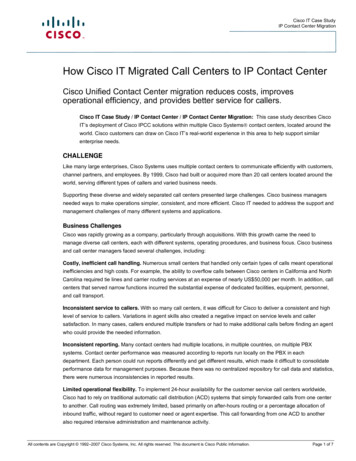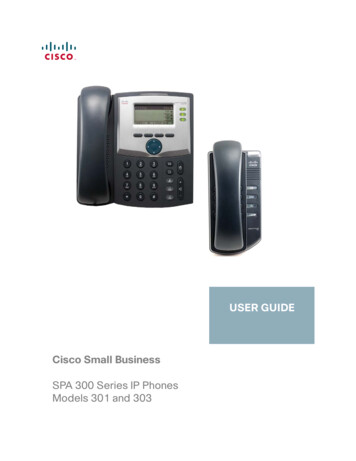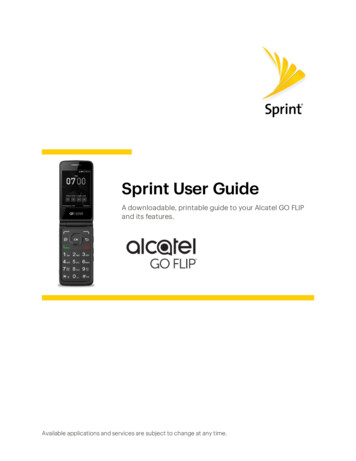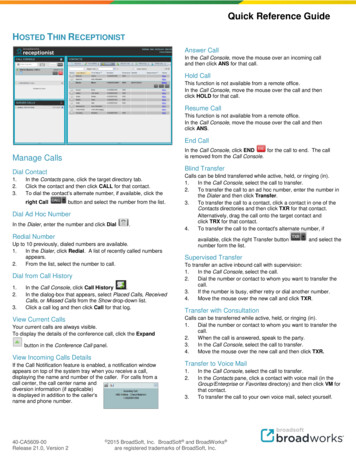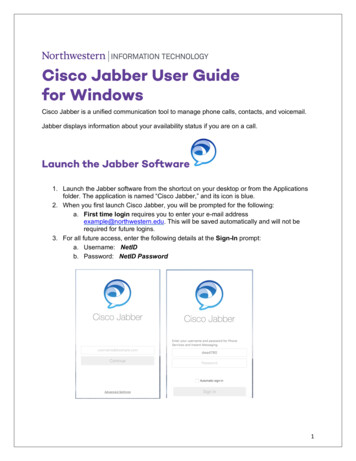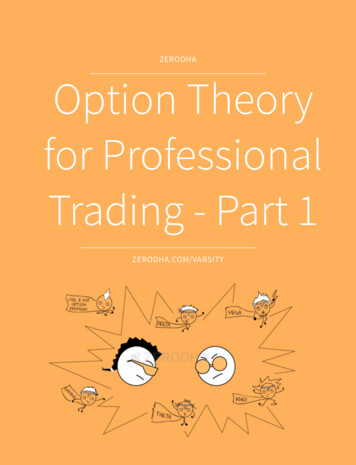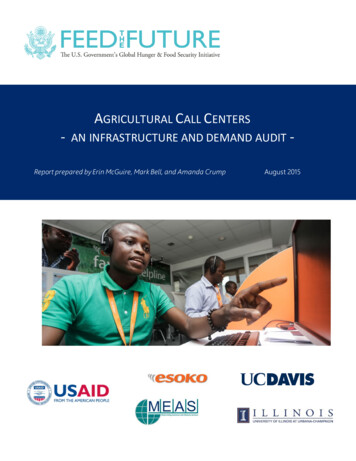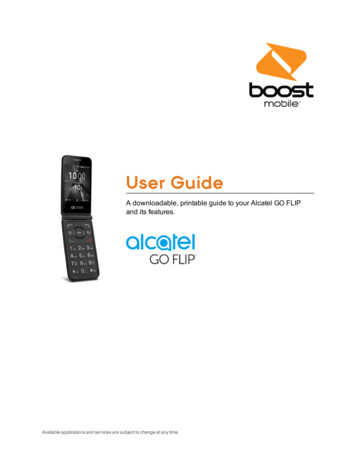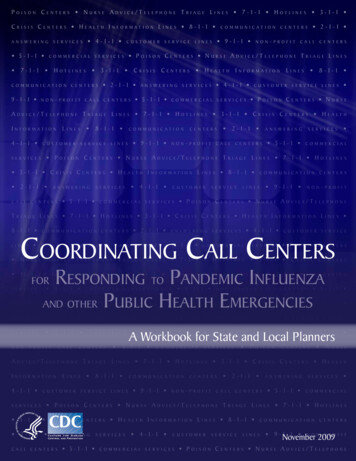
Transcription
Coordinating Call CentersResponding to Pandemic Influenzaand other Public Health EmergenciesforA Workbook for State and Local PlannersNovember 2009
The Oak Ridge Institute for Science and Education (ORISE) is a U.S. Department of Energy(DOE) facility focusing on scientific initiatives to research health risks from occupational hazards,assess environmental cleanup, respond to radiation medical emergencies, support national securityand emergency preparedness, and educate the next generation of scientists.This document was prepared for the Centers for Disease Control and Prevention (CDC) by ORISEthrough an interagency agreement with DOE. ORISE is managed by Oak Ridge AssociatedUniversities under DOE contract number DE-AC05-06OR23100.The findings and conclusions in this document are those of the authors and do not necessarilyrepresent the official position of the Centers for Disease Control and Prevention.
Coordinating Call Centersfor Responding to Pandemic Influenzaand Other Public Health Emergencies:A Workbook for State and Local PlannersPrepared forCenters for Disease Control and Prevention (CDC)Division of Healthcare Quality Promotion (DHQP)Prepared byOak Ridge Institute for Science and Education (ORISE)November 2009
Poison Centers Nurse Advice/Telephone Triage Lines 7-1-1 Hotlines 3 - 1A-bout1 ThisC rWi orkbooksis Centers Health Information Lines 8-1-1 c o m m u n i ca t i o nAbout This WorkbookIn October 2006 and March 2007, the U.S. Department of Transportation (DOT) NationalHighway Traffic Safety Administration (NHTSA) Office of Emergency Medical Services (OEMS)convened several stakeholder meetings to gather input and steer the development and clearance oftwo complementary guidance documents: Preparing for Pandemic Influenza: Recommendationsfor Protocol Development for 9-1-1 Personnel and Public Safety Answering Points (PSAPs) andEMS Pandemic Influenza Guidelines for Statewide Adoption. During these meetings, participantsexpressed an additional need to determine how 9-1-1 and Emergency Medical Services (EMS)would fit into the larger framework of public health and healthcare information lines. DOT/NHTSAand its partner U.S. Department of Health and Human Services (HHS) agencies concurred withthose expressed concerns and agreed it would be beneficial to hold an additional meeting with anexpanded group of stakeholders who provide healthcare or clinical information to the public viathe telephone.In further discussions convened by the Centers for Disease Control and Prevention (CDC) Divisionof Healthcare Quality Promotion (DHQP), CDC National Center for Health Marketing (NCHM),DOT/NHTSA, and the Agency for Healthcare Research and Quality (AHRQ), several issueswere identified that could be addressed during the expanded stakeholder meeting. Prior to themeeting, CDC DHQP and the Oak Ridge Institute for Science and Education (ORISE) engagedsubject matter experts involved in call center coordination, call center technology, and telephonetriage to determine which of the identified issues were most critical. Discussions highlighted largedisparities in the services call centers are able to provide at the state and local levels, and identifieda need for improving resource identification and coordination of call centers in communities atvarious levels of planning.Subsequently, an expanded stakeholder meeting was held in August 2008 to establish theframework for developing this workbook. The goal of the meeting was to identify the processfor coordinating call centers during an influenza pandemic, identify issues and obstacles that mayhinder the development of a coordinated call center system, and develop strategies to address theseissues and obstacles. Following the meeting, ongoing discussions were held with these stakeholdersthroughout the development of this workbook. It must be noted here that, without the assistance ofthese stakeholders (see Appendix D) this workbook could not have been produced.Coordinating Call Centersi
Poison Centers Nurse Advice/Telephone Triage Lines 7-1-1 Hotlines 3 - 1T-able1 of CContentsrisis Centers Health Information Lines 8-1-1 c o m m u n i ca t i o nTable of Before You BeginWorking Premise.7Guiding Principles.7Assumptions.9Predicted Impacts.11Current Issues.13OverviewWhat is a Call Center?.15Call Center Examples.15What is a Coordinated Call Center System?.18How Do You Develop a Coordinated Call Center System?.19How Much is it Going to Cost?.20How Do You Work Through This Workbook?.20Getting StartedHow to Approach Planning and Development.21Identify Your Initial Planning Team.22What are Your Planning Tasks?.41Establish Objectives for Your Coordinated Call Center System.41Identify Your Concept of Operations.45Look at What Other Communities Have Done.49Regroup with Your Planning Team.53Coordinating Call Centersiii
Poison Centers Nurse Advice/Telephone Triage Lines 7-1-1 Hotlines 3 - 1 - 1 C r i s i s C e n t e r s H e a l t h I n f o r m a t i o n L i n e s 8 - 1 - 1 Tcableo m m u n i ca t i o nof ContentsStep 1: Determine Where You AreIdentify Call Centers Operating in Your Community.59Determine Their Configuration.65Identify the Technologies Your Call Centers Utilize.65Identify Partnerships Your Call Centers Have with Other Call Centers forCoordinating with Each Other.67Survey Your Community's Call Centers.68Step 2: Determine Where You Need to BeWhat Services Will Your Coordinated Call Center System Provide?.81What Types of Calls Will Be Received During an Influenza Pandemic?.82How Many Calls Can Be Expected During an Influenza Pandemic?.82Who Will Be Making These Calls?.84What is Required to Manage These Calls?.85What Capabilities Do Your Existing Call Centers Have for Call ManagementDuring an Influenza Pandemic?.86Do Your Existing Call Centers Have the Capacity to Manage Calls During anInfluenza Pandemic?.89Does Your Community Have the Parts Needed to Develop a Coordinated CallCenter System?.90Step 3: Determine How You Are Going to Get ThereIdentify Solutions to Filling Your Gaps in Call Management and Shortages inSystem Parts.97Identify Obstacles to Implementing These Solutions.99Identify Strategies That Can Be Used to Overcome These Obstacles.100Step 4: Develop Your Coordinated Call Center SystemIdentify the Parts of Your Coordinated Call Center System.109Determine How You Are Going to Technically Integratethe Parts of Your System.119Identify Agreements or Plans That Need to Be Established.121Address the Needs of Those Involved in Your System.125Incorporate the News Media into Your Coordinated System.126ivCoordinating Call Centers
Poison Centers Nurse Advice/Telephone Triage Lines 7-1-1 Hotlines 3 - 1T-able1 of CContentsrisis Centers Health Information Lines 8-1-1 c o m m u n i ca t i o nStep 5: Launch Your Coordinated Call Center SystemEducate Your Community about Your Coordinated Call Center System.131Train Those Involved in Your System.132Test Your Coordinated Call Center System.137Step 6: Maintain Your Coordinated Call Center SystemMonitor Changes to Your System.141Determine How and When You Will Retest Your System.142Determine When to Incorporate New Technologies and/or Call dix A: Overview of the Incident Command System.149Appendix B: Coordinating Public Information.155Appendix C: Overview of 2-1-1.157Appendix D: Acknowledgements.159Appendix E: Resources.167Appendix F: Abbreviations/Acronyms.169Appendix G: Glossary of Terms.173Extra FormsExtra Forms.177Coordinating Call Centersv
Poison Centers Nurse Advice/Telephone Triage Lines 7-1-1 Hotlines 3 - 1P-reface1 Crisis Centers Health Information Lines 8-1-1 c o m m u n i ca t i o nPrefaceA pandemic is a global disease outbreak. A flu pandemic occurs when a new influenza virusemerges for which people have little or no immunity, and for which there may be no vaccineinitially. Influenza viruses spread easily person-to-person, causes serious illness, and can sweepacross the country and around the world in very short time.It is difficult to predict when the next influenza pandemic will occur or how severe it will be.Wherever and whenever a pandemic starts, everyone around the world is at risk. Countries might,through measures such as border closures and travel restrictions, delay arrival of the virus, butcannot stop it.A pandemic may come and go in waves, each of which can last for six to twelve weeks or moredepending on the jurisdiction.An especially severe influenza pandemic could lead to high levels of illness, death, social disruption,and economic loss. Everyday life would be disrupted because so many people in so many placesbecome seriously ill at the same time. Impacts can range from school and business closings to theinterruption of basic services such as public transportation and food delivery.A substantial percentage of the world's population will require some form of medical care.Healthcare facilities and systems can be overwhelmed, creating a shortage of hospital staff, beds,ventilators and other supplies. Surge capacity at non-traditional sites such as schools may need tobe created to cope with demand.The need for vaccine, once developed, is likely to outstrip supply, and the supply of antiviral drugsis also likely to be inadequate early in a pandemic. Difficult decisions may be needed in a severepandemic regarding who gets prioritized for antiviral drugs and vaccines and for medical attention.Death rates can be determined by several factors: the number of people who become infected; thevirulence of the virus; the underlying characteristics and vulnerability of affected populations; theavailability and effectiveness of treatment and prevention measures; and the extent to which thesemeasures are used in a timely fashion.Coordinating Call Centers1
Poison Centers Nurse Advice/Telephone Triage Lines 7-1-1 Hotlines 3 - 1Introduction-1 Crisis Centers Health Information Lines 8-1-1 c o m m u n i ca t i o nIntroductionIf you had to make a telephone call for help during an emergency, what's the first numberthat comes to mind? It's 9-1-1, isn't it? Suppose a quarter or half of your community triedto call 9-1-1 at the same time or even over a short period of time.What would happen then? Naturally, your community's 9-1-1 system would become completelyoverwhelmed and unable to respond to each request for help. Preventing such an unwantedscenario is the objective of this workbook and the goal of a coordinated call center system. Inshort, the overall objective of developing a coordinated call center system is to divert unnecessarycalls away from a community's 9-1-1 system and non-critically illThe overall objective ofpatients away from the healthcare system. As will be explaineddeveloping a coordinatedlater, this diversion will be accomplished in two ways: (1) educatingcall center system is to divertunnecessary calls from athe public to call the coordinated call center system directly andcommunity's 9-1-1 system and(2) designing the system so that your community's 9-1-1 system(s)non-critically ill patients awaycan transfer calls to the system, thus moving calls off of the 9-1-1from the healthcare system.network.The universal emergency number 9-1-1 is just one of many numbers that ties into what is termed acall center. Briefly, a call center is an interface (both human resource and technological) betweenan operator (either human or technological) and a caller seeking assistance or information. 9-1-1and 4-1-1 are probably the more "traditional" call centers you recognize, but there are many moretypes of call centers operating within and outside of your community. For example, you mayhave a poison center or a crisis hotline or a nurse advice line operating in your community. Thesesame call centers may be operating at a regional or state level. It is these additional call centersthat you want to tap into to manage non-emergency calls (and perhaps some emergency calls)during an influenza pandemic or other major public health emergency in order to reserve your9-1-1 and healthcare systems for those in critical need of medical services. Tapping into theseadditional resources for call management is how you develop a coordinated call center system.This workbook will lead you through a step-by-step process for developing this system.One question that probably has come to your mind is, "Why should I develop a coordinated callcenter system?" The answer to this question is simple. It will be extremely beneficial to yourcommunity in more ways than you might expect. For example, consider the following benefits:Coordinating Call Centers3
Poison Centers Nurse Advice/Telephone Triage Lines 7-1-1 Hotlines 3-1-1 Crisis Centers Health Information Lines 8-1-1 c o m m u n i ca t i o nIntroduction A coordinated call center system results in a "sharing"Why should I develop aof the load." By coordinating call centers, no single entitycoordinated call centeraccepts the "full load" of calls that would surge into a callsystem?"center during an influenza pandemic or other major publichealth emergency. Instead, the management of calls is spread across multiple entities. A coordinated call center system can be used for efficient allocation of communityservices and resources. Because the system is a coordinated and organized effort amongmany agencies and organizations, services and resources can be allocated effectively andefficiently, rather than haphazardly as would be the result of an unplanned or disorganizedeffort. A coordinated call center system will enhance public perception and trust ofinformation being disseminated. The public relies on information that is on time, up todate, consistent, and accessible. In developing your coordinated call center system, youwill be ensuring that you can provide this type of information. The development of a coordinated call center system makes an agency or organizationconsider its own planning requirements. The development of a coordinated call centersystem requires planning efforts and input from a variety of agencies and organizations. Itis during this planning effort that these agencies or organizations might realize that thereare additional planning requirements they might not have considered, such as continuityof operations planning. A coordinated call center system can be used as a disease surveillance tool. Callsto the system can be monitored for "spikes" in disease reporting (or other emergencysituations) in certain sectors of the community. Subsequently, the appropriate agenciescould be alerted of the evolving situation.Another question you're probably asking is, how does a coordinated call center system work?In a nutshell, it ties a network of call centers together to provide three services: (1) triage—sortby criticality—the call to determine where to route it, (2) triage the caller to determine the levelof medical care needed, and (3) disseminate information to your community to keep it informedand up to date on the status of the pandemic and what to do or where to go to seek medicalcare. Additionally, your coordinated system could be tapped into by one of your neighboringcommunities that is short on resources.4Coordinating Call Centers
Poison Centers Nurse Advice/Telephone Triage Lines 7-1-1 Hotlines 3 - 1Introduction-1 Crisis Centers Health Information Lines 8-1-1 c o m m u n i ca t i o nAt first glance, a coordinated call center system may look like it is human resource intensive. Itdoesn't have to be. Technology plays just as important a role as human resources in the system. Intoday's ever changing world of technology, there are many technological advances available foryou to use. For example, Interactive Voice Response (IVR), Automatic Call Distribution (ACD),or Uniform Call Distribution (UCD) can serve as automated call routing systems. These are butthree types of technologies available for you to use, and they, along with other technologies, arediscussed in this workbook.By now you may be thinking that developing a coordinated call center system is beyond yourcapabilities. You needn't think that way. This workbook was designed by a group of subjectmatter experts with the knowledge that each community differs in size and resource availability. Itprovides a step-by-step process to developing the system using existing community resources. Italso provides strategies for overcoming resource shortages or other obstacles you may encounter.Even though you may think the task impossible to accomplish, this workbook shows you thatthere is, in fact, a way to accomplish it.For those of you who liveand work in communitieswith few or no resources, thisworkbook applies to you aswell.For those of you who live and work in communities with little orno resources, this workbook applies to you as well. You can stillmanage the task of developing a coordinated system with what isavailable in your community. You may have to possibly partnerwith a neighboring community. Or you may need to work with oneor more private sector call centers. The point to be made here is that the steps and strategies outlinedin this workbook can be scaled down to apply to even the most resource-strapped communities.You may have to "think outside of the box," but it can be done.One thing you need to note is that this document is a workbook. It takes a hands-on approach tohelp you work through a step-by-step process for identifying and coordinating your community'scall centers. It includes worksheets for you to fill out as you progress through each step of thedevelopment process. It also includes appendices of useful information. Consider this workbookto be your "teacher" as you work through the process.On a final note, while the purpose of this workbook is to provide state and local planners with aframework for coordinating call centers during an influenza pandemic, such a framework is anextension of the "traditional" all-hazards approach to planning and preparedness. As such, thestrategies for developing a coordinated call center system described in this workbook essentiallycould be used to mitigate most widespread public health emergencies, such as severe acuterespiratory syndrome (SARS) or an anthrax attack.Coordinating Call Centers5
Poison Centers Nurse Advice/Telephone Triage Lines 7-1-1 Hotlines 3 - 1B-efore1 YouC rBieginsis Centers Health Information Lines 8-1-1 c o m m u n i ca t i o nBefore You BeginThere are a number of "ground rules"—premises, principles, assumptions, predictions, andissues—that you need to review before you begin the task of developing your coordinatedcall center system. These will give you the proper mindset as you go about the task ofdeveloping your system.Working PremiseThis workbook was developed under the premise that, in most emergency situations, the public willuse the telephone—landline, cell phone, or Internet phone— as their method of communicatingwith emergency response agencies for requests for information or services, and that, whilecommunities differ in size and technological capabilities, all have access to, at the very least, basictelephone system(s). Therefore, when discussing the development of a coordinated call centersystem, the approach in this workbook will be to coordinate the community's basic communicationcapabilities and then branch out to other alternative technologies and strategies.The concept of coordinating call centers is relatively new; therefore, developing a coordinated callcenter system is not an exact science. As such, some of the suggestions made in this workbookmay work for some communities and not others. The key point is that this workbook provides theframework for a community to work with its existing resources to do the best job that it can do indeveloping a coordinated call center system.Guiding PrinciplesAs you move forward in developing your community's coordinated call center system, keep inmind these guiding principles which should serve as the foundation for your system's development:1. Developing a coordinated call center system is a relationship building exercise. Youneed to engage your partners early in your development effort, and you will need tocontinue to engage them throughout the process. Additionally, as communities change ortechnology changes, you will need to continually look for new partners to incorporate intoyour system.Coordinating Call Centers7
Poison Centers Nurse Advice/Telephone Triage Lines 7-1-1 Hotlines 3-1-1 Crisis Centers Health Information Lines 8-1-1 c o m m u n i ca t i o nBefore You Begin2. When developing your coordinated system, you must work within your community'sresources. It is the intent of this workbook that a community work within its existing callcenter framework/system to coordinate calls for medical treatment, advice, or informationduring an influenza pandemic or other public health emergency. It is not the intent ofthe workbook to mandate that a community develop a new framework/system. For somecommunities, developing a new framework/system is not possible. Therefore, you mustwork with those call centers and human resources that are currently available to yourcommunity. For those instances where availability is lacking, this workbook providesstrategies to address this issue.3. Developing a coordinated call center system takes time. The steps outlined in thisworkbook cannot be worked through from start to finish in a short period of time. Youmust commit the requisite time to complete each step. SomeDeveloping a coordinatedsteps may require only days while others may require weekscall center system takes timeor even longer. In the end, the benefits of your time andand is a team effort.effort commitment will be evident.4. Developing a coordinated call center system is a team effort. You cannot tackle thetask by yourself. You need to assemble a knowledgeable team and delegate tasks. Sincesome steps or tasks outlined in this workbook do not have to be completed in order, youcould delegate different steps or tasks to your team members and, as a result, save sometime.5. Disseminating information is just as important as answering calls in a coordinated callcenter system. One method to divert unnecessary calls from 9-1-1 and non-critically illpatients from the healthcare system is to disseminate information to the general public onwho to call or what to do in certain situations. This information dissemination also servesto keep the public informed and as comfortable as can be expected with the situation athand.6. The more educated and comfortable the public is with your coordinated call centersystem, the more likely they will be to adhere to the expectations you place on them.In the face of a public health emergency, the public is predictable in their actions. Theywill use the communication mode that is most comfortable to them. They will do whateverit takes to get care for themselves and their loved ones. They will not accept medicalinformation provided by the media as a substitute for direct interaction with a medicalprofessional. Given this predictability, it would be in the community planner's best interestto inform the public of the scope and intent of the coordinated call center system from the8Coordinating Call Centers
Poison Centers Nurse Advice/Telephone Triage Lines 7-1-1 Hotlines 3 - 1B-efore1 YouC rBieginsis Centers Health Information Lines 8-1-1 c o m m u n i ca t i o nvery start of the planning process and continuously—(and repeatedly)—educate them onthis scope and intent as well as the expectations being placed on them.7. Although designed with the intent of lessening the impact of an influenza pandemic,your coordinated call center system also can be used to assist in the response to otheremergencies. You are not just designing a pandemic specific system. Your coordinatedsystem can benefit your community in other emergencies as well.8. During an influenza pandemic (or other public health emergency) incident, yourcoordinated call center system will operate within the framework of your community'sIncident Command System (ICS). Your call center systemDuring an influenzawill be an organized, coordinated effort. Likewise, ICS ispandemic (or other publican organized, coordinated approach to managing incidents,health emergency) incident,your coordinated calland has become a widely adopted (and sometimes required)center system will operateapproach to incident management across the country. It iswithin the framework ofextremely important that your system operate within theyour community's IncidentCommand System (ICS).ICS framework.AssumptionsThe actual impact of an influenza pandemic on the United States is not known. As a result, currentpandemic influenza planning efforts incorporate many assumptions about its predicted impacton a community. Some of these assumptions for a severe pandemic are shown below, and theseassumptions were used in the development of this workbook. This workbook was developed priorto the 2009 H1N1 pandemic and does not include scenarios for a less severe pandemic such asthis one where older adults are not susceptible and hospitalization and death rates are lower thanin other pandemics. In an affected community, multiple waves (periods during which community outbreaksoccur across the country) of illness could occur with each wave lasting six to twelve
for coordinating call centers during an influenza pandemic, identify issues and obstacles that may hinder the development of a coordinated call center system, and develop strategies to address these issues and obstacles. Following the meeting, ongoing discussions were held with these
